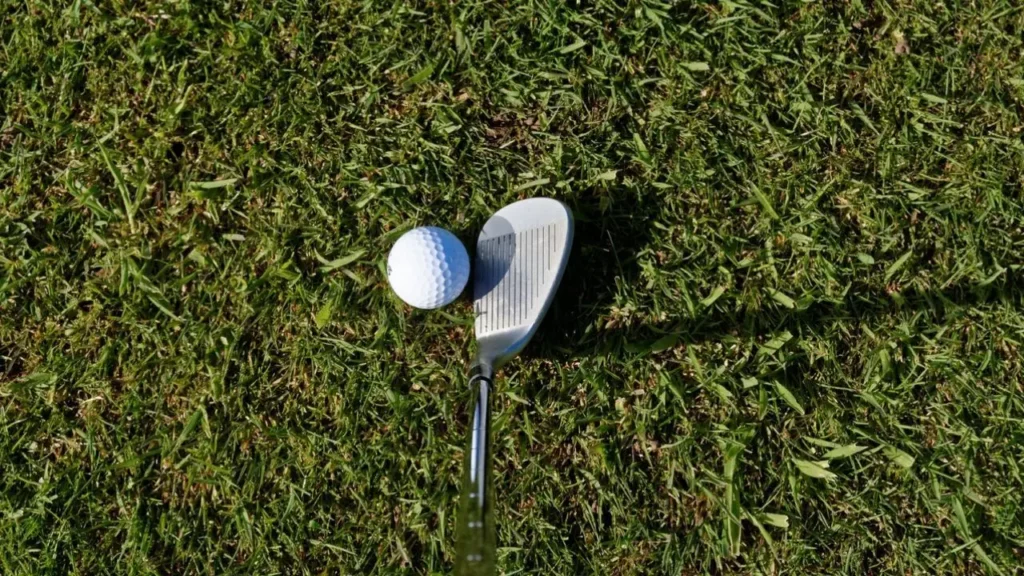From Amateur to Pro: Your Guide to Average Wedge Distance
- Last updated on March 18, 2024
- Toni Benedito
- Golf Equipment & Gear, Blog
Pitching wedges for amateurs typically cover 100–120 yards, while gap wedges range from 80 to 110 yards. Sand wedges may reach 100 yards, influenced by factors like loft angle, swing speed, and weather conditions. To improve wedge distance, know your abilities, practice with various wedges, and consider external factors. Use a golf wedge distance chart for informed decisions on the course.

Key Takeaways
- Wedges come in three primary types: pitching wedges (PW), gap wedges (GW), and sand wedges (SW), each with different loft angles affecting ball trajectory and distance.
- Typically, amateur golfers can expect their pitching wedge to travel around 100–120 yards. Gap wedges and sand wedges have variable distances, influenced by factors like swing speed and skill level.
- Wedge distance is affected by loft angle, swing speed, ball compression, and environmental conditions. Awareness of these factors aids in selecting the right wedge for specific scenarios on the course.
- To enhance wedge performance, assess your ability level, practice with different wedges, and understand loft angles. Consistent practice, combined with knowledge of your swing speeds, contributes to better short-game results.
- Utilizing a wedge distance chart provides valuable insights into loft angles and average distances, aiding golfers in making informed club selections. While averages vary, these charts serve as useful tools for players of all skill levels.
Introduction
Today, we’re delving into a crucial aspect of the game that can significantly impact your scores – the average wedge distance. Whether you’re a seasoned pro looking to fine-tune your short game or a budding golfer eager to understand the nuances of wedge play, this blog post is your ultimate guide.
Join us as we explore the intricacies of wedge types, decipher the average distances for each, and uncover the factors that influence your wedge performance. So, grab your clubs, hit the greens with us, and let’s elevate your golfing experience together!
Enjoying this article? Read more:
Check out this video below from Golf Sidekick EXTRAS YouTube channel:
Now, picture this: you’re standing on the fairway, contemplating your next move. The right wedge choice can be the game-changer, determining whether you nail that precise shot onto the green or find yourself caught in the rough. In the realm of golf, knowledge is power, and understanding the average wedge distance opens the door to strategic decision-making on the course.
Ready to unlock the secrets that can propel your wedge game to new heights? Let’s tee off into the details!

Understanding Golf Wedges
When it comes to golf, wedges are an essential part of any golfer’s arsenal. Wedges are arguably the most important club in a golfer’s bag.
They allow players to hit high, soft shots that stop quickly on the green or rough. But what exactly are golf wedges?
Wedges are a subset of irons and typically come in four different types: pitching wedge, gap wedge, sand wedge, and lob wedge. Each type has its unique characteristics and is designed for specific situations on the course.
Pitching wedges have the lowest loft angles and are designed for shots between 100 and 125 yards away from the green. Gap wedges are used when there is a gap between the range of your pitching wedge and sand wedge distances.
"Wedges are a golfer's secret weapon, crucial for high, soft shots that stop on a dime. With pitching, gap, sand, and lob wedges each serving a specific purpose, understanding their unique characteristics is key. Knowing the distance capabilities of each wedge in your bag ensures strategic shot selection and overall game improvement."
Sand wedges have higher lofts than pitching and gap wedges; they’re designed to help get out of bunkers or navigate through thick, rough patches. Lob wedges are typically used for shorter shots around the greens when you need to get up high and stop your ball quickly without much roll.
They can be tricky to use because of their high degree of angle (over 60 degrees), which can make them difficult to control if you aren’t careful. While pros might use more types of wedges than amateurs due to their skill level, understanding each type will help you fill gaps in your game related to the distances required on a course.
It’s important to know how far you hit each club in your bag, including your different types of golf wedges, so that you can better judge which one to use based on distance from the hole or where you need it on a particular shot. Keeping track of this information will not only help you improve your game but will also allow for consistency in hitting your clubs overall.
Enjoying this article? Read more:

Average Distances for Different Wedges
When it comes to golf, the wedge is perhaps the most important club in your bag. Wedges are essential tools for getting out of difficult situations and getting your ball onto the green. But how far should you be hitting them?
Understanding average wedge distances can help you improve your game and, ultimately, lower your score. There are different types of wedges, each with their own loft angles and distances.
The pitching wedge typically has the lowest loft angle, usually around 45 degrees, and is used for shots that need to cover a longer distance. On average, a pro golfer can hit their pitching wedge between 130 and 150 yards, while an amateur player’s average distance would be anywhere from 80 to 110 yards.
The sand wedge, on the other hand, has a higher loft angle (usually around 56 degrees) and is ideal for shots out of bunkers or other sandy areas. Pro golfers can hit their sand wedges between 90 and 110 yards on average, while amateurs will likely hit theirs between 50 and 80 yards.
"Mastering golf wedges is crucial for navigating various scenarios. From the long-reaching pitching wedge to the versatile gap wedge and the lofty lob wedge, understanding average distances empowers your game. Pro golfers and amateurs alike benefit from knowing their wedge ranges, enhancing shot precision and lowering overall scores."
Another type of wedge is the gap wedge or approach wedge. This club has a loft angle between that of a pitching wedge and a sand wedge (usually around 50–54 degrees), making it perfect for filling gaps in yardage between clubs.
Pro golfers can hit their gap wedges between 105 and 125 yards on average, while amateurs will typically hit theirs between 70 and 100 yards. There’s the lob wedge with its high loft angle (usually around 60 degrees).
This club is perfect for short shots that need to go high into the air without covering a lot of distance. Pro golfers usually hit their lob wedges between 75 and 95 yards on average, while amateurs will typically get about half that distance.
Ultimately, understanding these golf wedge distances helps you choose which club to use when measuring distances so that you can get closer to hitting your target consistently. A golf wedge distance chart would be a handy tool to use when out on the course, but remember that these distances are just averages.
Your own ability and swing style will also play a significant role in determining how far you hit your wedges. With enough practice, you can improve your wedge distances and become more accurate with your shots.

Factors Influencing Wedge Distance
Understanding wedge distance is a pivotal skill in golf, particularly when approaching the green. Achieving accuracy and consistency in wedge shots involves considering several key factors. Loft angle plays a crucial role, influencing how high the ball launches. For example, the loft angle of a pitching wedge ranges from 44 to 48 degrees, while sand wedges vary between 54 and 58 degrees.
Diversifying wedge types based on loft angles can address specific shot requirements.
- Loft Angle Impact: The loft angle, representing the face-to-vertical plane angle, significantly affects wedge distance. A higher loft launches the ball higher in the air.
- Diverse Wedge Types: Varying loft angles in wedge types, like pitching (44–48 degrees) and sand wedges (54–58 degrees), cater to different shot demands, especially around the green or in sand hazards.
- Gender Influence: Interestingly, gender plays a role in wedge distance. Men, generally generating more clubhead speed, achieve greater distances. Women with less powerful swings benefit from club heads with added weight.
- Environmental Factors: Wind direction, speed, and humidity levels are critical environmental factors impacting wedge distances during measurements on golf courses.
- Pro vs. Amateur Impact: Professionals’ refined techniques versus amateurs’ need for swing consistency contribute to accurate wedge distances. Amateurs can benefit from golf wedge distance charts and degree charts, coupled with practice drills for improvement.
Mastering wedge distance involves a nuanced understanding of loft angles, diverse wedge types, gender influences, and environmental factors.
Whether you’re a seasoned pro or an aspiring amateur, leveraging golf wedge distance charts and degree charts, along with dedicated practice drills, is key to enhancing accuracy and consistency in approaching shots. This ultimate guide offers valuable insights for golfers aiming to elevate their wedge game.
Enjoying this article? Read more:
Check out this video below from Golf Sidekick EXTRAS YouTube channel:
How to Improve Your Wedge Distance
Improving your wedge distance is a key aspect of improving your overall golf game. There are a few things you can do to increase the distance you get from your wedges:
- First, make sure you have the right wedge types in your bag. As we discussed earlier, different wedge types have different degrees and loft angles. This will affect the distances you can achieve with each club. By having a range of degrees available, you’ll be able to fill gaps in your game and hit wedges that are appropriate for each shot.
- Another way to improve your wedge distance is by practicing measuring distances. Knowing exactly how far you can hit each type of club is essential for making good decisions on the course. A distance chart or degree chart can help with this, but ultimately it comes down to spending time on the range and getting a feel for how far each club goes.
- It’s also important to consider your ability level when trying to improve wedge distance. Pro golfers may be able to achieve longer distances than amateur golfers due to their experience and skill level. Don’t try to compare yourself too much with others; focus on making incremental improvements based on where you’re currently at.
There are some common mistakes that golfers make when trying to improve their wedge distance:
- One is using too much force or swinging too hard; this can lead to shorter distances as it throws off your accuracy and timing.
- Another mistake is not taking into account different course conditions or wind patterns, which may affect how far the ball travels.
By following these tips and incorporating them into your practice routine, you’ll be well on your way toward improving your average wedge distances and becoming a more well-rounded golfer overall!
Enjoying this article? Read more:

Wedge Distance Charts
One of the most important aspects of golf is the ability to hit your wedges with accuracy and precision. While many factors go into determining how far you can hit your wedges, using a wedge distance chart can be extremely helpful in getting a clearer picture of what distances you’re generally capable of hitting.
There are many different types of wedge distance charts available online, but one of the most common is the degree chart.
This type of chart lists out all the different loft angles for each type of wedge, along with an average distance that a golfer with moderate ability should be able to hit their ball. These charts can help fill gaps in your game by identifying areas where you may need to work on improving your ability with specific types of wedges.
For example, if you find that you’re consistently falling short on shots that require a 60-degree wedge, it may be time to focus on improving your technique with this particular club. While pro golfers tend to have longer wedge averages than amateurs due to their superior ability and training, using a wedge distance guide can still be useful for players at any skill level.
Measuring distances accurately is essential for making informed decisions on the course, and knowing how far you can realistically expect to hit your shots will help reduce errors in judgment. It’s important to remember that these charts are just averages, and every golfer’s abilities differ based on factors such as age, sex, and experience.
But even if they’re not perfect representations of what each player is capable of doing, they provide a good baseline from which players can work toward improvement. Whether used by pros or amateurs, these tools can be invaluable aids when it comes down to making those crucial shots off the green.

Enjoying this article? Read more:
Check out this video below from Golf Sidekick EXTRAS YouTube channel:
Common Mistakes and How to Avoid Them
If you’re striving to enhance your wedge game, steering clear of common mistakes is key. Let’s dive into some pitfalls that can significantly impact your wedge distance and ways to sidestep them.
Mistakes to avoid:
Choosing the Wrong Wedge Type: One prevalent error is selecting the wrong wedge type for a shot. Each wedge comes with distinct loft angles, and using the inappropriate one can throw off your average wedge distances. Refer to the ultimate guide to wedges to understand which wedges suit different situations. Always identify the wedge you’re using before taking that swing.
Mismatching Club and Ability: Another misstep is not aligning the club choice with your skill level. For amateur golfers, attempting a shot with a challenging 60-degree lob wedge might lead to frustration. Opt for a club that strikes a balance between comfort and functionality. Instead of struggling with a challenging club, choose one that suits your abilities while still covering the necessary distance.
Swinging Too Hard: Wedges require finesse, not sheer power. Unlike drivers or woods, swinging too hard with wedges can lead to overshooting or missing the target altogether. Focus on precision and control due to the shorter shafts of these clubs. A measured swing is more likely to get you closer to your target than a forceful one.
Overreliance on the Golf Wedge Distance Chart: Relying too heavily on a golf wedge distance chart can be a limiting factor. Averages vary among golfers, and skill levels play a crucial role. Instead of fixating on averages, practice hitting each club to understand how far they go in your hands specifically. Tailoring your approach to your unique capabilities is key.
Elevating your wedge game involves steering clear of these common mistakes. By selecting the right wedge, aligning clubs with your ability, maintaining control of your swings, and understanding your distances, you’ll find yourself on the path to wedge mastery.
Keep these insights in mind during your next round to see a positive impact on your overall performance.
Enjoying this article? Read more:

Conclusion
Mastering your wedge distance is crucial to improving your game and lowering your golf scores. Throughout this ultimate guide on average wedge distances, we’ve covered a lot of ground.
We began by discussing the different types of wedges and loft angles, followed by the average distances for each type of wedge. It’s important to note that these averages can vary greatly depending on factors like swing speed and weather conditions.
We then explored various factors that can influence your wedge distance, such as ball compression, turf interaction, and clubhead speed. Armed with this knowledge, you can take steps to improve your consistency and maximize your distance on the course.
One key takeaway from this guide is that measuring distances accurately is essential when it comes to hitting wedges consistently. Using a golf wedge distance chart can help you determine which club to use based on how far you need to hit the ball.
We discussed some common mistakes golfers make when it comes to their wedge game and how you can avoid them. Keep in mind that even professional golfers struggle with their wedges at times—this is a challenging aspect of the game for everyone!
Overall, understanding average wedge distances is just one piece of the puzzle when it comes to improving your golf game. But armed with this information and some practice time on the range or green, you’ll be well on your way to hitting your wedges with confidence and precision on every hole!
Share this Post
Toni Benedito
Keep Reading
Follow Us
Recent Posts

How Do Pro Golfers Get Paid? The Business of Golf
Professional golfers get paid both before and after tournaments. Before a tournament, they receive appearance fees, sometimes exceeding $1 million, to attract top players. After the tournament, earnings depend on their placement, with the PGA

How Much Do Golf Players And Pros Make? You Won’t Believe It!
Professional golfers earn substantial incomes through tournament winnings, sponsorship deals, and endorsements. Top players on the PGA Tour can make millions annually, with significant earnings from prize money and lucrative brand partnerships. For example, Rory

The Shocking Cost: How Much Does It Cost to Fly with Golf Clubs?
Flying with golf clubs can be a hassle, but it’s worth it for avid golfers. Costs vary by airline, ranging from $30 to $150 per way. Southwest Airlines offers a generous policy, allowing one set

Why Do Golfers Tape Their Fingers Before Hitting the Course?
Golfers tape their fingers to prevent injuries from repetitive motions, provide support for existing injuries, and improve grip comfort. It’s a popular technique among amateurs and pros alike, offering a lightweight and effective solution compared

How Much Does a Round of Golf Cost? Are You on Par?
The cost of a round of golf varies widely based on factors like course type, location, and time of play. Public courses typically range from $30-$100 per round, while exclusive ones like Augusta National or

Hidden Fees: How Much Does It Cost To Rent a Golf Cart
Wondering how much it costs to rent a golf cart? Explore factors like location, rental duration, and cart type impacting prices. Daily rates range from $50 to $80, while weekly rentals can vary from $200
Table of Contents







